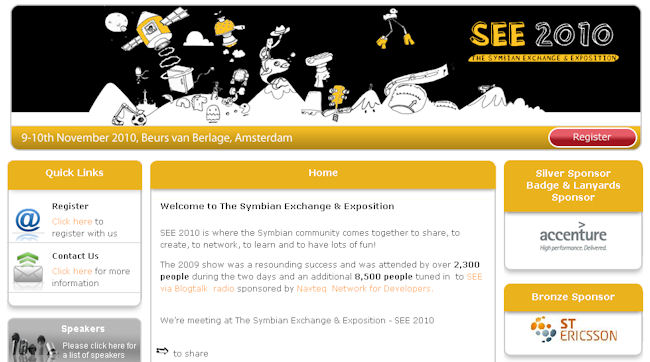The exact details for SEE 2010 have yet to be announced, but the show will no doubt include the usual mix of exhibition, keynotes, training sessions and networking opportunities. SEE 2010 currently has two sponsors - Accenture and ST Ericsson, but more are likely to be added before November. Here is our live picture gallery from SEE 2009, which gives a quick flavour of last year's event.
By November a variety of Symbian^3 devices will have been announced and some of them, such as the Nokia N8, will be available in retail. The show will come ahead of the critical Symbian^4 release, which will see a full rework of the default Symbian UI and a move to Qt as the default application / software framework. The Symbian^4 and Symbian^5 releases are widely expected to widen and reinvigorate the Symbian ecosystem, building on the step-wise work of Symbian^3.
While Symbian^3 is the first full open source release of the platform much of the early work on it dates back to the time before the Symbian Foundation was formed. The Symbian Foundation is moving towards a faster release cadence - roughly two releases a year. However platform releases do take a significant time to move from the drawing board to a hardened release in the repositories. Indeed the current Symbian releases (Symbian^1, Symbian^2 and Symbian^3) are, to an extent, suffering from legacy architectural constraints and a period under-investment three to four years ago, most notable in the UI layers (what was S60).
This is one of the key reasons Symbian is facing wide spread external criticism, most obviously around the UI, but also in its general attractiveness to manufacturers in the face of the rising tide of Android.
Symbian^4 will be the first release to attempt to fully address UX concerns, but it will be Symbian^5 that can most accurately be described as a product of the Symbian Foundation methodology (open source led by contributions) from beginning to end. Symbian^5 should also see some of the maturation of current technology programs such as SMP (symmetric multi processing) and SHAI (Symbian hardware abstraction interface), which could give the Symbian platform a significant technical edge over its competitors.
This situation is relatively poorly understood outside the inner core of the Symbian ecosystem. Thus SEE 2010 gives the Symbian Foundation the opportunity to lay out its future direction and plans, as well as its vision for the future of mobile.

